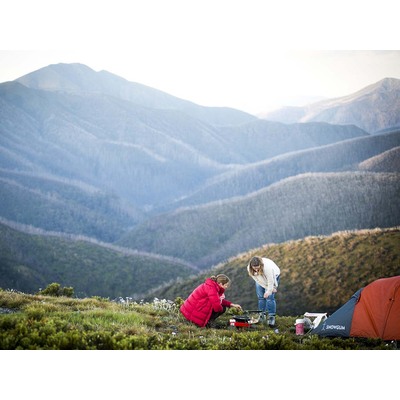Warm Up Your Winter Trip
The start of the winter season is upon us. Though some areas do get colder than others, we have a tendency to become acclimatised to our area, and so at some point, most of us will feel the drop in temperature. For those headed to chillier locales in the coming months, the following few tips are for you.
We have divided these tips into three broad categories, consisting of:
- Food
- Sleeping Accommodations-
- Clothing
Food
Food is one of the easiest ways to raise your body temperature while camping in cold environments. Eating regularly and eating
Hearty soups, casseroles and stews are fantastic for providing delicious healthy meals that will warm you from the inside out, and there are lots of yummy recipes available at the touch of your fingertips. The Primus 7L Thermal Cooker is a great addition to the kitchen as it can cook all day while you go off on an adventure, and it can cook both sweet and savoury meals.
As most people know, breakfast jumpstarts your metabolism and, like dinner, provides your body with the fuel to get your biological systems running effectively. However, it is recommended that you eat regularly throughout the day to maintain the warmth you need for the day.
A warm beverage is also a quick and easy way to raise your body’s core temperature. However, caffeine increases blood flow to the skin so it is best to stick with decaffeinated and herbal hot drinks. It is also a good idea to avoid alcohol, as it too can reduce your core body temperature even though it may initially give you a boost of warmth. As a side note, don’t forget to drink plenty of water!
Sleeping Accommodations
The first thing you should be familiar with prior to setting off on your winter camping trip is your ideal temperature for sleep.
As individuals, everyone has different preferences. Some people sleep better in a cool environment while others require warmth for a true good night’s rest. Once you’ve identified your ideal sleeping temperature, this can be used to gauge the sleeping accommodations you will require.
When it comes to winter time travelling, a sleeping bag is the standard bedding option. Nevertheless, it is important to ensure that you have plenty of warm blankets available should you need some additional warmth.
It is important to know that not every sleeping bag is created equally. One thing you should be considering is the rating of the sleeping bag.
To pick a sleeping bag with the correct temperature rating for your trip, try to gauge the lowest temperature you’ll be camping in. Take this temperature and subtract 10 from it. This is your ideal sleeping bag rating. So say, for example, the lowest temperature you’ll be encountering is 0 degrees Celsius. When you subtract 10 from this temperature, you get -10 degrees Celsius. Therefore, you should be looking into a sleeping bag rated at -10 degrees, just to be safe. When it comes to Australia, most people do fine with a sleeping bag rated somewhere between 0 and -10.
If you start sweating in your sleeping bag, your insulating material won’t work as well as it should. Down especially is ineffective once wet. For this reason, you should never sleep and breathe with your head in the bag, as this too introduces it to moisture.
During your winter camping trip, also remember to dry out your sleeping bag as often as possible. This will provide you the maximum heat during your sleeping hours.
Additionally, shake out your sleeping bag prior to getting in. You want the insulating layer to be as expanded as possible in order to efficiently trap and conduct the warmth of the air.
Clothing
There is one ultimate clothing rule when it comes to wintertime camping. That rule is to layer, layer, layer. For example, start with some long johns. Then add some thin sweat pants and a t-shirt. Next, a bigger sweater and some jeans. And lastly, maybe a waterproof windbreaker or jacket.
Layers allow you to account for both temperature increases and decreases. Just be sure that you are not too cold with your full outfit on. Once you’ve got that part covered, you can always remove a layer or two if you start getting too hot.
When you’re planning your layered outfit, also be sure to consider what types of activities you will be engaging in. Generally, the more physically strenuous the task, the lighter the layers you will require.
Working out automatically increases your body’s temperature. Therefore, if you’re planning for vigorous activity, you will likely need fewer layers than someone who will be simply sitting around and chatting with friends.
Focus on your extremities (head, hands, feet) as this is where most body heat is lost. Always be sure to have warm footwear, mittens and hats on-hand.
Lastly, when it comes to winter camping, try to avoid cotton clothing as cotton absorbs moisture, which can in turn rob you of your much needed body heat, so keep the cottons for the summer camping trips. Whenever possible, opt for waterproof materials and thick knits with liners is ideal.
A few extra tips:
- Invest in a few high-quality floor coverings or caravan rugs. These will greatly aid in keeping your feet (and your whole body) cosy and warm.
- You can add an annex or awning walls to your awning to increase your “inside” space. This will give you a bit more room to do your daily activities without having to brave the full extent of the outside chill. You can also add a draft kit for additional protection from the wind and rain.
- Invest in a heater that will suit your accommodation and needs. There is a range of different heating options available including gas, electric and diesel, as well as indoor and outdoor heaters and multi-purpose heaters that double as cookers too.
DISCLAIMER* Please note, this advice is general in nature and we strongly recommend consulting the product manual and where relevant, a professional installer.







